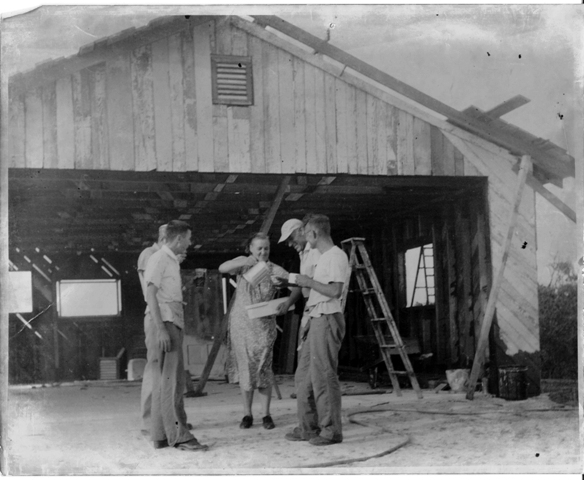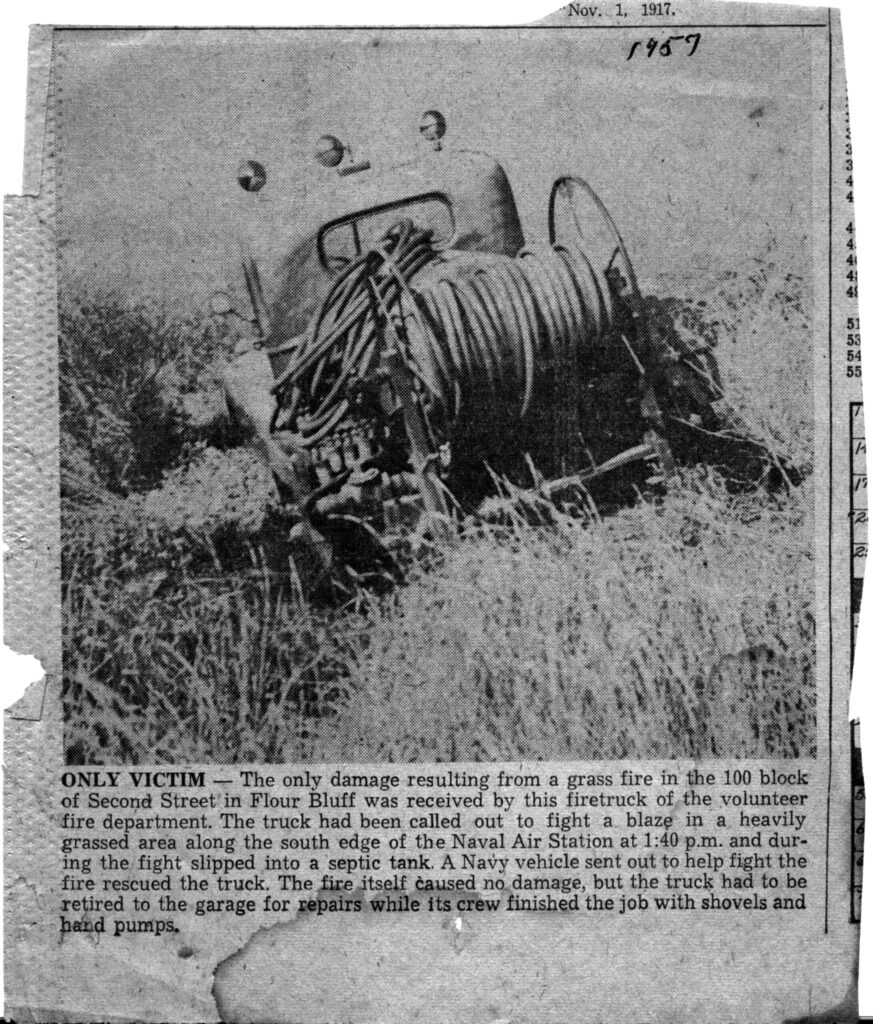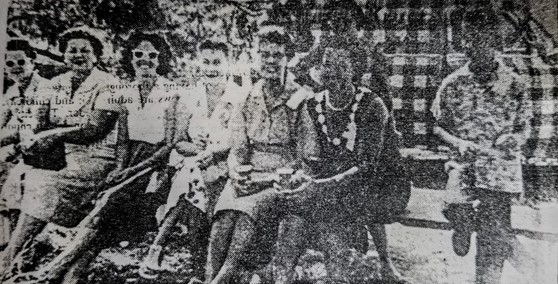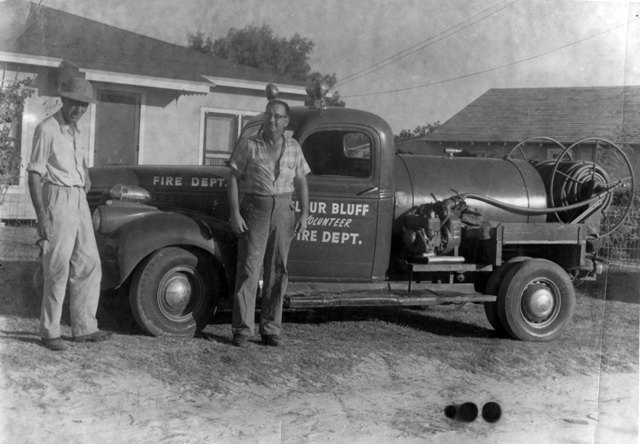To preserve the rich history of Flour Bluff, The Paper Trail News, will run historical pieces and personal accounts about the life and times of the people who have inhabited the Encinal Peninsula. Each edition will feature the stories gleaned from interviews held with people who remember what it was like to live and work in Flour Bluff in the old days. You won’t want to miss any of these amazing stories.
If you’re like some of the newcomers in Flour Bluff, Padre Island, and NAS Corpus Christi, you may have wondered what all those sirens are about in the first weeks of December each year. Well, it’s just Santa making his rounds handing out candy to all who turn out to see him pass by on a float created by the Flour Bluff Volunteer Fire Department, or as they are officially named, Nueces County ESD#2. For those who grew up in Flour Bluff, this event is one they want to share with their own children and grandchildren. It is a tradition that requires countless hours of work and a great deal of fundraising and generosity of time and money to prepare for the eight nights of magic that kids never forget and something that costs the taxpayer nothing. It’s done out of the goodness of the hearts of those who simply want to bring a little cheer to the children of the area.
The jolly old elf has been portrayed by various folks since the first float made its rounds in 1962. The first Santa, Ed Stoll, served as a Flour Bluff FD volunteer for most of his life and also worked as an NAS Corpus Christi firefighter. Stoll said in a 1986 Caller-Times article that serving as Santa Claus on the first FBFD float was among the highlights of his career. This seems to be the sentiment of just about every volunteer who has a hand in the yearly Christmas tradition. But just who are these volunteers, and when did this organization get its start?
Since the first settlers arrived on the Encinal Peninsula in the 1890s during the Ropes Boom, the area’s residents had relied upon their neighbors in times of emergency. The fire department on NAS Corpus Christi assisted with fires and other emergencies once they came upon the scene in 1941. Still, the people of Flour Bluff knew they needed more.
The exact start date for the Flour Bluff volunteers varies depending on the source. Annie Poldrack who resided at 533 Webb was a member of the department’s women’s auxiliary and wife of original volunteer Rudolph “Bill” Poldrack told a Caller-Times reporter in an early 1980s interview that residents made inquiries to the state about forming a volunteer department as early as 1952.

(L to R) Lee Essig looks on as his mother, Josephine, serves up a hot cup of coffee to his dad, Jay. If anyone can identify the other two men, please contact the editor of Texas Shoreline News. (Photo courtesy of Dale Scott)
Jay L. Essig, who lived at 254 Lakeside Drive with his wife Josephine, offered up time, property, and money to serve the people.
“It was to help people, to help make our town a safer place,” Josephine told a Caller-Times reporter in 1981. “You just felt better in getting out and helping people.”
In 1954, a group of 15 volunteers came together to help the community and simply started serving. At that time, the volunteers only had a 1940s model Ford pickup which they had converted into a small pumper fire engine by replacing its load bed with a 500-gallon water tank. The Essig’s garage housed the vehicle. Jay L. Essig, a former maintenance supervisor for the Flour Bluff School District, was the first chief of the department.
When a fire flared up in the early years of the department, someone would call the Essig home. They had a separate phone number to handle the emergency calls. Mrs. Essig would sound the siren then make individual calls to all the volunteers while her husband prepared to fight a fire.
In those days, the members raced to the fire scenes in their personal cars. These cars were unmarked, so all the member had their vehicles equipped with sirens to allow them to move quickly through traffic. Most roads in Flour Bluff in the 1950s were single- or double-lane roads, which could create a bit of a problem. The Essigs’ 1951 Kaiser Manhattan sedan had its own siren.
In 1956, the Flour Bluff Volunteer Fire Department was officially recognized as such by the state. R.L. Strom became chief. Bill Poldrack was an officer in the department’s formative years. He, too, used his car, a 1950 Ford V-8 with a siren, to respond to fires.
Funding was a constant problem for the early department. It relied completely on donations and fundraisers. Once, a firetruck ran out of gas at a fire, and members had to dig in their pockets right there to buy enough fuel to get back to the station, Mrs. Essig told the reporter. If a firetruck went down, there was fundraising to be done.
In 1957, the only firetruck the volunteers possessed suffered an “injury” when they answered a call. According to a clipping found in a former FBVFD Chief’s scrapbook, “The only damage resulting from a grass fire in the 100 block of Second Street in Flour Bluff was received by this firetruck of the volunteer fire department. The truck had been called out to fight a blaze in a heavily grassed area along the south edge of Naval Air Station at 1:40 p.m. and during the fight slipped into a septic tank. A Navy vehicle sent out to help fight the fire rescued the truck. The fire itself caused no damage, but the truck had to be retired to the garage for repairs while its crew finished the job with shovels and hand pumps.”

The first fire truck goes down at a grass fire in 1957. (Flour Bluff Reporter photo courtesy of Bernie Arnold collection)
To help with the financial woes, the wives formed a women’s auxiliary for the department. They held barbecues, sold Marion Kay spices, made quilts to raffle off, and even made and sold dolls to raise funds. Throughout the 1950s, they helped keep the organization afloat with what seemed a never-ending series of fundraising events.
Many fundraisers were held at Humble Camp, a housing area provided by Humble for its employees. (Today it is a mobile home park – once known as Marina Village – just outside the South Gate on NAS Drive.) Mrs. Essig sometimes took photographs of the fires and took them to local television stations for them to use on the news and hopefully draw support for the department. One of the most successful fundraisers was in 1957, according to Mrs. Poldrack. The auxiliary raised $400 at an auction. This money was used to purchase a resuscitator in 1958.

Auxiliary members also supported the firefighters in the field, supplying them with water and food. This is a 1956 photo of the ladies’ auxiliary (L to R) Ruby Sutton, Lucille Ott, Pat Ellis, Josephine Essig, Lois Cabaniss, Annie Poldrack and son John Poldrack. Behind Mrs. Poldrack is daughter Barbara. (Photo courtesy of Dale Scott)
By 1960, the results of the fundraising and some donations were realized. The department had three trucks to go with the other equipment they were able to buy. At the same time, community interest seemed to have fallen, which meant the financial support waned. This forced the remaining faithful members to mount a campaign for the creation of a rural fire prevention district which could levy taxes to fund the department. They also built the station that once stood near Davis Drive (South Padre Island Drive) on Laguna Shores Road.
The voters came through passing the measure by a margin of 373 to 159 – more than two to one. That day the Nueces County Rural Fire Prevention District No. 2 was born. For its first year, a tax of three cents for every $100 worth of property was levied on Flour Bluff residents, and it remains the same today.
In 1961, Flour Bluff was annexed as part of the territory of the city of Corpus Christi, but the first city fire department would not be built until the late 1970s and a second one on the island in the 1980s. That same year, Ed Stoll, now deceased, joined the FBVFD. He was third assistant chief and president of the volunteers. Stoll saw that things at the station were informal and that the firefighters needed constant training, something that Stoll knew well as a training officer.
The arrival of Ed Stoll brought with it a new direction for the Flour Bluff volunteers, something that would serve them well in the years to come. The Texas Shoreline News will look at the changes the department experienced in the next issue.
_________________________________________________________________
The writer welcomes all corrections or additions to the stories to assist in creating a clearer picture of the past. Please contact the editor at [email protected] to submit a story about the early days of Flour Bluff.

